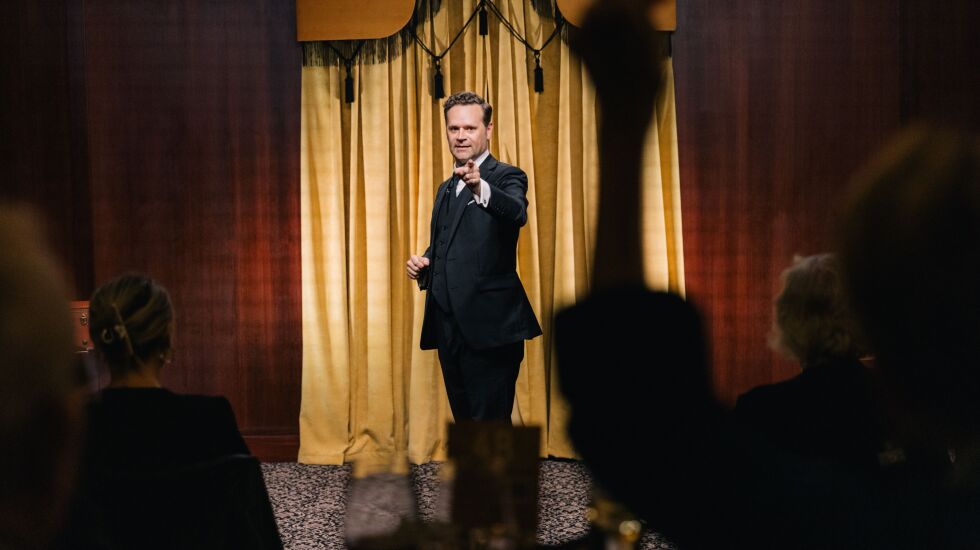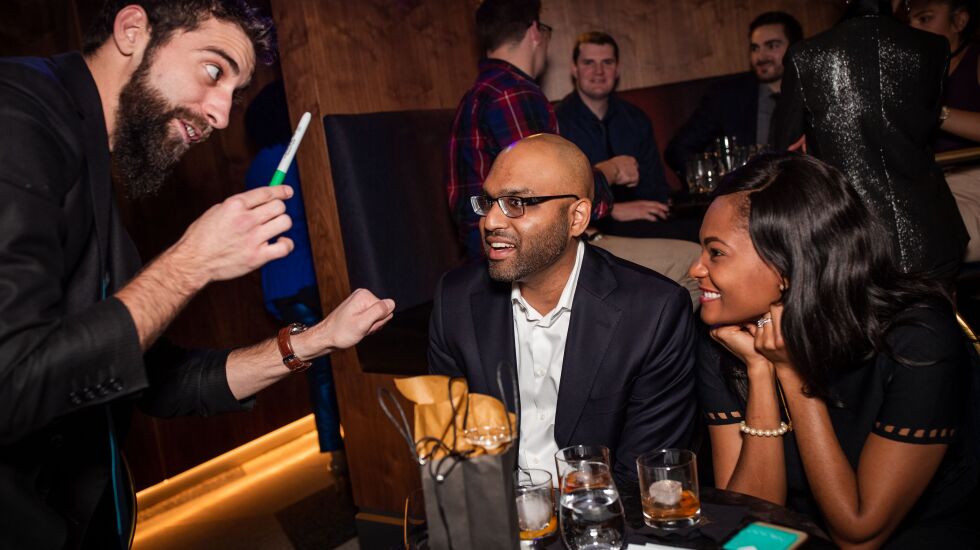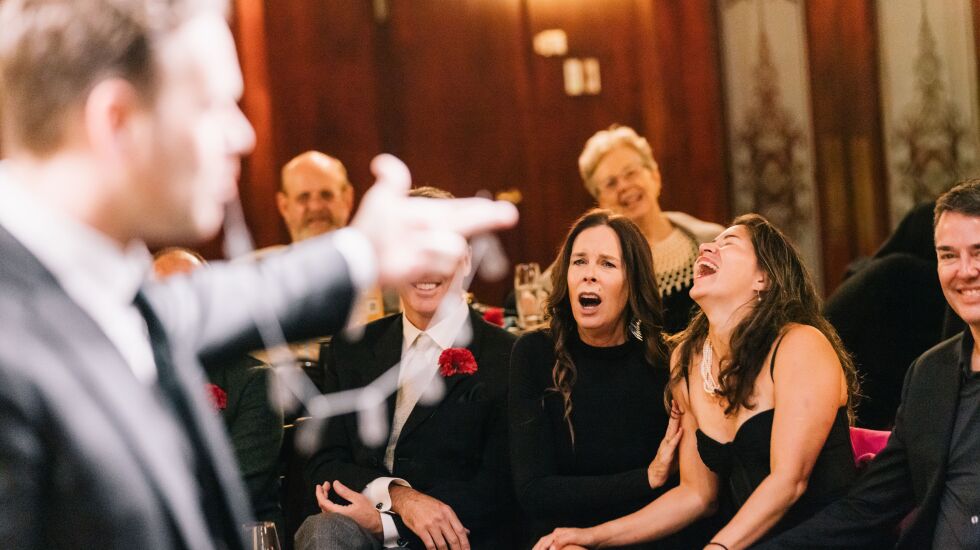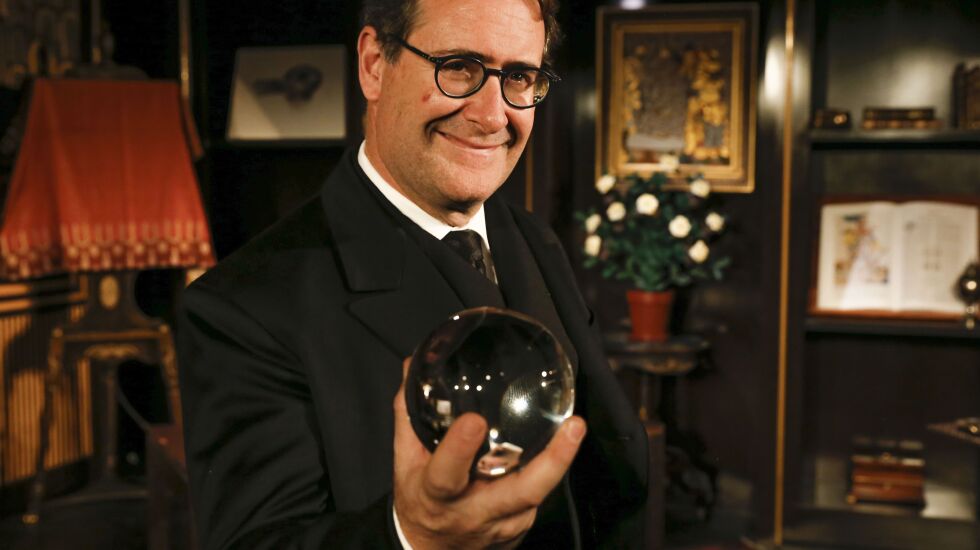
On any given night in Chicago right now, you can find magicians dazzling audiences in an elegant underground Loop parlor, a rehabbed Rogers Park vaudeville theater or an Andersonville cabaret hidden behind the façade of an industrial laundry.
There’s even a newish gelato shop in Lincoln Square where magicians sling cards and conjure up other illusions while serving twisted flavors such as Elf Crack.
Magic is a big deal in Chicago, and it has been for a long time, but it’s especially popular at the moment, with a growing number of shows and venues.
“There’s a lot of magic happening in Chicago now,” said John Sturk, a Chicagoan who’s the national president of the Society of American Magicians. “There used to be dozens and dozens of magic bars and theaters and places to see shows. And then they kind of just slowly faded away. But around about 10 years ago, there started to be more.”
Is Chicago the best city for magic?
“I think it’s getting to be,” said Dennis Watkins, who’s been astounding audiences with his seeming ability to read minds since 2008, when he launched his long-running show The Magic Parlour. Back in that time, “there were only a couple of other magic shows in Chicago,” he said. “Today, there are just so many. It’s everywhere.”
Watkins moved his show this fall from the Palmer House Hilton to a dedicated space in the basement of Petterino’s restaurant, working in partnership with the adjacent Goodman Theatre.
Ricardo Rosenkranz, a doctor who performs as the Physician Magician and runs the Rhapsody Theater magic venue in Rogers Park, traces the current boom back to older magicians who served as mentors, such as his own teacher, Eugene Burger, who died in 2017. “There were a few mentors — Eugene is probably the most important one — who just created a whole generation,” he said. “That generation is finding a way to perform here. I think that explains the enthusiasm and the venues.”
The new curiosity also may be driven by TV shows with magicians front and center, such as the CW’s “Penn & Teller: Fool Us,” NBC’s “America’s Got Talent” and Netflix’s “Death by Magic.”

Penn Jillette of “Fool Us” is an investor in Sideshow Gelato, a Lincoln Square shop that opened in the spring, selling gelato while hosting shows by magicians, sword-swallowers and other sideshow acts. He visited the store this fall, performed some card magic and even “got behind the counter and threw gelato around for a while,” said Jay Bliznick, the owner. On another occasion, “Teller came in and did Houdini’s East Indian needle trick.”
“Our motto is ‘The magic is back,’ ” said Joey Cranford, who opened the Chicago Magic Lounge in Andersonville in 2018, giving it a speakeasy vibe by concealing it behind that laundry façade on Clark Street.
“It’s about reclaiming Chicago as an epicenter for magic,” Cranford said.
A magic metropolis
Chicago was such an epicenter back in the 1890s and early 1900s, the Golden Age of Magic, when world-famous illusionists like Harry Houdini and Harry Blackstone Sr. performed in the city’s theaters. But as that era faded around 1930, Chicago entered its own local heyday for the craft, according to author David Witter.
“In the years following the Great Depression, everyone from movie stars to gangsters to children and adults of all ages witnessed magic in Chicago,” Witter wrote in his 2013 book “Chicago Magic: A History of Stagecraft & Spectacle.” “In fact, live magic and magic acts rivaled the big bands in terms of popularity in the Windy City.”
Magic shops flourished — including Magic Inc., which began as the Ireland Magic Co. in 1926 and is still in business, now located at 1838 W. Lawrence Ave. It’s said to be North America’s oldest continually operating family-run brick-and-mortar magic store.
Meanwhile, Chicago magicians were working in smaller venues: bars, restaurants and cabarets. That’s where they developed a style of close-up magic. “Magicians would just line up behind the bar and do a lot of card tricks,” Cranford said. “Funny, fast-paced stuff.”

All of this history is vividly told through the vintage posters, books and magic props on display inside Chicago Magic Lounge, which also hosts a club for the city’s performing magicians, called the Chicago Magic Roundtable.
Looking back on the mid-20th century, Cranford said: “We were a magic hub. But all that went away. A lot of performers would go to the Magic Castle in Hollywood, and then they would just live out there. And the magic kind of left Chicago.”
Now, as Chicago magic enjoys a fresh renaissance, the close-up style remains important. It’s a regular feature at Sideshow Gelato, and not just during scheduled performances. Magicians of all levels regularly walk around the shop and burnish a card trick or sleight of hand to gelato-slurping visitors. “Any of the staff, myself included, will perform if somebody walks in just to get a gelato,” Bliznick said.
Chicago Magic Lounge was set up as a showcase for close-up magic, with card tricks performed at the front bar alongside bartenders serving cocktails. Magicians perform at customers’ tables inside the venue’s 107-seat, art-deco-style Harry Blackstone Cabaret Theater, which also serves as a platform for larger illusions. And a premium ticket will get you inside the 654 Club, where 43 seats are arranged in rows like a tiny lecture hall.
“The magician just works right here on this table,” Cranford said. “You can see everything so clear.”
Watkins, a master of the close-up style, decided to leave the Palmer House after performing there for 12 years because the Goodman Theatre and Petterino’s offered an enclosed space where he could install his own lighting, sound system, cameras and video screens.
“The Palmer House was a glorious home for the show,” he said. “There’s no other Chicago hotel lobby like it.” But the new venue “was exactly what I need,” he said. “It’s important to me that our show remains a close-up magic show for 60 or fewer guests, because that’s the kind of magic that I do best. And that’s the perfect space.”

Like the Chicago Magic Lounge, Watkins’ Magic Parlour offers an extra experience for ticket buyers who pay more. After the main show, Watkins sits down with those guests at a round table, amiably chatting as he performs a shell game and card tricks right in front of their eyes.
“What Dennis and his team were able to do to transform the space has been fantastic,” said Roche Schulfer, the Goodman’s executive director and CEO. And ticket sales have been strong, he said. Watkins will be the only performer in the Magic Parlour space for the foreseeable future, but eventually, Schulfer said, “we may branch out and have guest magicians in there, and performers from other backgrounds.”
Chicago Magic Lounge and the Rhapsody both feature a mix of local magicians and touring artists. Through Jan. 7, the Rhapsody’s star attraction is British magician Jamie Allan, who performs some old-fashioned tricks involving cards, ropes and seemingly torn-up newspapers as well as impressive feats using newer gadgets like iPads and iPhones.
Rosenkranz, a Mexico City native who moved to Chicago in 1990, saw the need for a venue for longer-form magic shows with a story arc, so he opened the Rhapsody in June 2022, refurbishing the former Mayne Stage concert venue, which originally had opened as the Morse Theater vaudeville house in 1912.
A shared experience
Rosenkranz also teaches a “Medicine Magic” class at Northwestern University Feinberg School of Medicine, where he’s an assistant professor in clinical pediatrics, and he often performs his own “Physician Magician” show at the Rhapsody.
“Magic provides a type of healing,” he said. “Most magicians, in one way, are healing people — so that they can get respite from the world or have tools of hope and positivity to deal with whatever they’re dealing with.”

Like Rosenkranz, Watkins doesn’t like using the word “trick” to describe what he does. “The point is never to trick somebody,” he said. Watkins learned magic from his grandfather in Texas. “My granddad would say magic is a moment where we all share in something that is mysterious.”
Cranford follows a similar philosophy, adopted from Matt Schulien, who performed magic at a legendary restaurant called Schulien’s on Irving Park Road.
“He said, ‘Magic is people,’ ” Cranford said. “It’s the person-to-person relationship when you’re showing them an amazing trick or a little bit of the impossible. It’s allowing that person in on a miraculous moment that they wouldn’t normally have.”
And now, as magic shows multiply, Chicagoans have more opportunities to see such miraculous moments. “We seem to have the soul of magic here in Chicago,” Rosenkranz said.
Robert Loerzel is a journalist based in Chicago.







